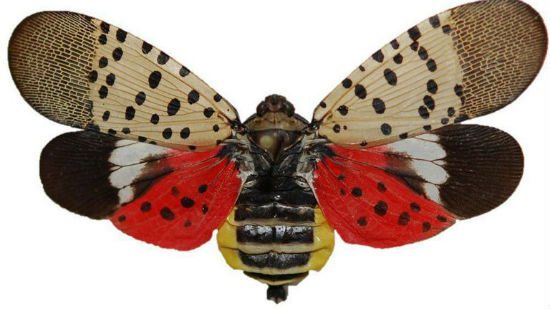The spotted lanternfly is pretty. I’ve noticed this every time I’ve killed one, which is quite a bit lately from here in southeastern Pennsylvania, inside the quarantine zone for these exotic invasive pests.
Lanternflies have “environmentalists seeing red,” Antonio Planas write for Newsday, in a report on the recent spread of the insect to Long Island. And, yes, that’s true — environmentalists are among those concerned about the effect this new, rapidly spreading, unchecked-by-predators species is having on our local ecosystem.

But like all “environmental issues,” it’s not only or mainly environmentalists who are upset or concerned. It’s farmers, nurseries, orchards, golf courses, parks, facilities managers — everybody whose livelihood around here involves or depends on the health and well-being of trees. And that’s a lot of people. Like all “environmental issues,” this is also an economic issue.
Planas understands that, too, I think, even from up there on Long Island:
A colorful insect that has environmentalists seeing red because of the harmful effects it has on agriculture was found at a tree nursery in Deer Park, state officials said Friday.
One live and several dead spotted lanternflies, tree- and crop-damaging invasive insects that are native to Asia and were first spotted in Pennsylvania in 2014, were found at the nursery, officials said in a statement.
Personnel with the New York State Department of Environmental Conservation and the Department of Agriculture and Markets said the adult insects were in a shipment originating from an area that is under quarantine in Pennsylvania. …
“DEC is working proactively with our partners at the State Department of Agriculture and Markets to do everything we can to keep spotted lanternfly out of New York State and to prevent infestations,” DEC Commissioner Basil Seggos said in a statement. “In addition to our ongoing education, outreach, and survey efforts across the state, we are closely tracking spotted lanternfly, a destructive invasive pest that has the potential to severely impact our state’s agricultural and tourism industries.”
Best wishes to the officials in New York. I hope they’re consulting with officials here in Pa., because our folks can help supply a long list of measures that haven’t really worked yet.
The Lanternfly Situation had me revisiting a post here from close to 15 years ago. This was about melaleuca trees and endless wars and creating databases of resistance fighters to arm against the enemies of the day. Some of the current-events mentioned in the post are no longer current. Some always will be. But here’s the text of that post.
I know an old lady …
I know an old lady who swallowed a cow
I don’t know how she swallowed that cow …
I’m fascinated by stories of exotic invasives — those surprisingly adaptable foreign species like kudzu or the cane toad whose proliferation in a new ecosystem can have devastating consequences.
… She swallowed the cow to catch the dog …
A few years back I had dinner with a fellow who worked as a biologist for the state of Florida. He was working specifically on the problem of the melaleuca trees that are choking out native vegetation in the Everglades. As such, he was an expert on the potentially disastrous consequences of importing exotic species, even with the best of intentions.
His plan for dealing with the infestation of melaleucas, however, involved just such an enterprise. The problem in Florida, he said, was that the trees did not have to contend with any of their native predators. He advocated the importation of an Australian beetle — the melaleuca snout beetle — as a means of curtailing the spread of the trees. (This plan has since been adopted.)
… She swallowed the dog to catch the cat …
So, I asked him, the solution to the problem of invasive exotics is to introduce more invasive exotics? Aren’t there a million ways this could go wrong? He recognized the potential for unforeseen and unintended consequences, but, he reassured me, they had studied this carefully and were confident they could account for all the variables.
… She swallowed the cat to catch the bird …
I hope he’s right. I hope the plan works and the snout beetles (and now psyllids, a second aphid-like Australian foe of the melaleuca) succeed in saving Florida’s ecosystem from the trees from Oz without further complications. And I hope that, as the biologist assured me, the foreign insects will simply die out once their supply of melaleuca is diminished.
But what if they don’t? What if we’re not quite as in control of the situation as we like to think, and the snout beetles tastes adapt to their new surroundings?
… She swallowed the bird to catch the spider
Which wriggled and jiggled and tickled inside her …
The biological and ecological conundrums posed by exotic invasives have parallels in the world of foreign policy and international relations. There too, today’s solution may become tomorrow’s pest. Yesterday’s friend may become today’s foe.
… She swallowed the spider to catch the fly …
Here too, the experts assure us that they have considered all the variables — that they do not foresee or intend any unforeseen or unintended consequences. Yet here, too, I worry that there are more variables in play than we can account for — that we have not fully considered what might happen if this doesn’t work, or even what might happen if it does.
… And I don’t know why she swallowed the fly
Perhaps she’ll die.
This chaotic multiplicity of variables and the inevitability of unintended consequences does not mean, of course, that we must passively do nothing. Neither melaleuca trees nor tyrants should be allowed to prosper unchallenged. But we do have a responsibility to ensure that our proposed solution does not wind up making things worse. We cannot forever continue the cycle of importing exotic species to counter the effects of the exotic species we imported.
I know an old lady who swallowed a horse …












